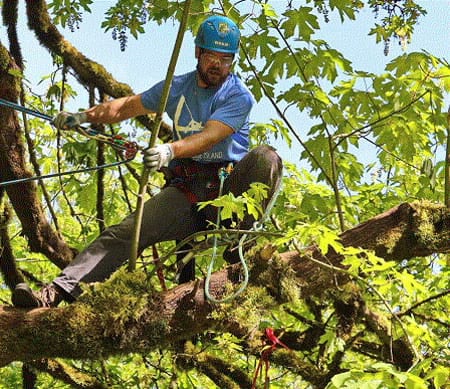 The Seattle City (spot)Light shines on David Bayard, supervisor for the Powerline Clearance group in City Light’s Transmission and Distribution.
The Seattle City (spot)Light shines on David Bayard, supervisor for the Powerline Clearance group in City Light’s Transmission and Distribution. This week’s Seattle City (spot)Light shines on David Bayard, the supervisor for the Powerline Clearance group in City Light’s Transmission and Distribution.
David is responsible for vegetation management along 1,770 miles of overhead lines in the City Light service area and beyond. He has worked at City Light for five years, and he came to the utility with an undergrad degree in English from Lewis and Clark College in Portland, OR and a master’s degree in Sustainable International Development from Brandeis University in Waltham, MA.

City Light’s David Bayard in a tree-climbing competition, April 2016
I got out of school with a English degree in Romantic literature and couldn’t land a job in that field, so I started climbing trees. I began working as residential arborist in 2000. I liked being outdoors and didn’t see myself in an office. I knew I wanted to be physically active with something related to the environment.
I got a job with a tree company and moved out to San Francisco from Boston a year later. Every time I’ve moved I have been able to find a job in arboriculture with no problem. I realized it was something I could do sustainably and got interested in arboriculture as a career.
The focus of my grad studies was ecotourism, but when I got out of grad school in 2008 the global economy crashed. Development agencies and non-profits were firing people left and right. So I moved with my wife to Seattle in 2010 and got a job at Seattle City Light.
When I came into City Light’s vegetation management program, the program wasn’t advancing as quickly as the industry was changing. I saw places where I could stick my nose in and get involved, and eventually my boss created a supervisory position. I applied for it and got it.
A big driver for me has always been connecting people to their environment in a way that is meaningful and impactful to them. When I moved to Seattle in 2010, I had this idea to bring people up into the trees. I started a recreational tree-climbing company, got a business license and started lobbying the Parks department to let us operate as a concession for the public. The Parks department has the biggest and best trees in Seattle.
Now we do one climb a month, April through October. That day is often the best day of the month for me. I get to spend the whole sharing this gorgeous, awe-inspiring 110-foot red oak in Volunteer Park. We bring people up 50-60 feet. It’s very empowering, especially for young people and people that have a fear of heights. They ascend under their own power, so they can look around and think ‘I did this!’ When folks come down, it’s just smile after smile.
Being in the forest and surrounded by trees has its own feeling. There is something different about it. We connect to the natural world through trees in a way that only happens when that connection is alive. Trees are living, breathing things. They have communities. They are directly involved in their neighborhood. And they are huge.
I know that people will never forget their climbing experience, and the hope is that they draw on it when it comes time to vote on land use or decide where to put their money or resources towards conservation.